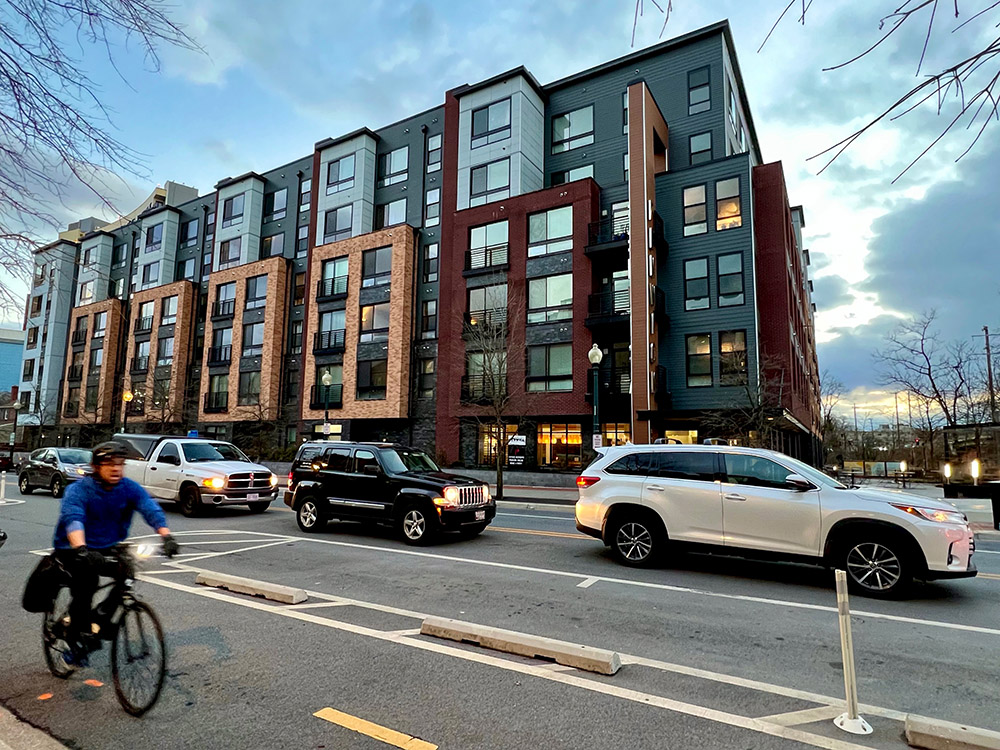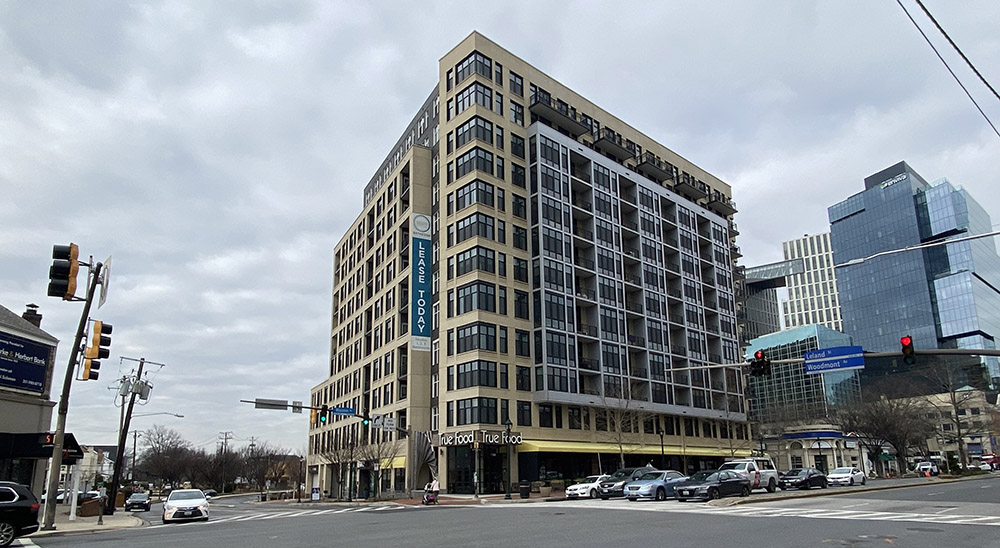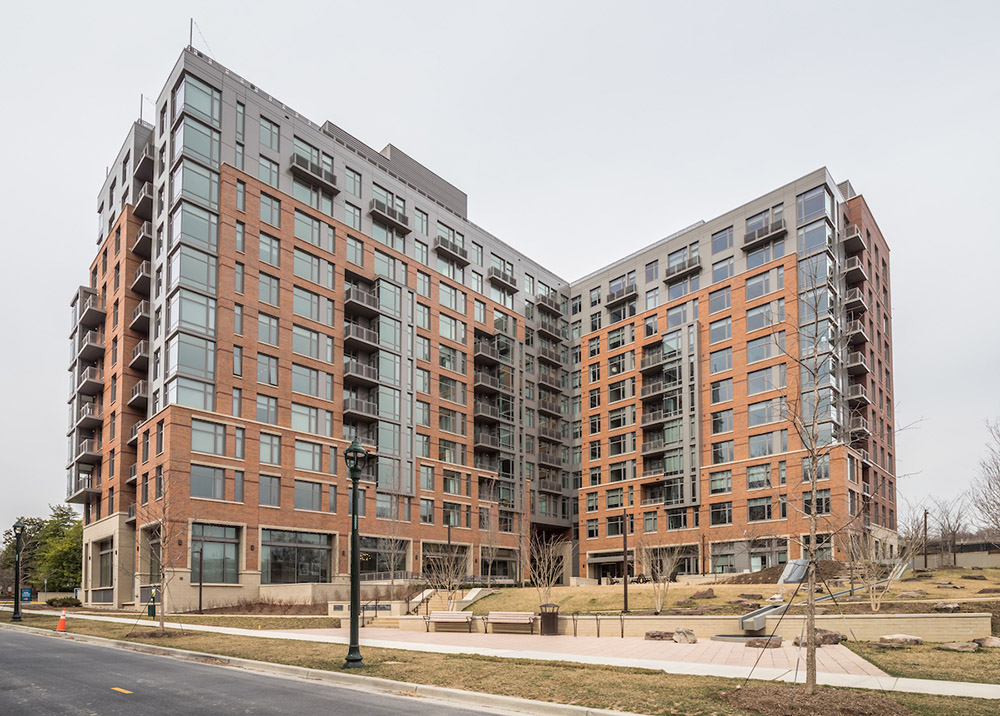By Lisa Govoni and Jason Sartori
One of Montgomery Planning’s mantras of late has been this idea of turning “parking lots to places.” In other words, let’s make better use of underutilized developed land and transform it into something more vibrant with multiple uses for residents and visitors. Inherent in “parking lots to places” is the thought that the “easier” parcels to redevelop – like surface parking lots – will be developed first, given the complexity and time involved in redevelopment of sites with existing uses.

Fenwick Apartments in Silver Spring (310 units, 39 Moderately Price Dwelling Units) replaced a one-story, aging United States Postal Service building and its parking lot.
Turning a parking lot into a place is infill development, which takes place on vacant or underutilized developed parcels within an area that have access to existing services. Infill development is beneficial to the county in many ways as we’re turning asphalt into livable, walkable, and exciting places. These new developments help us meet our climate goals too by upgrading stormwater management, reducing heat island effects, creating more walkable environments, and adding housing in areas closer to amenities, jobs, and transit. Planning staff’s examination of 40 residential, infill development projects built from 2012 to 2021 in downtown Bethesda and downtown Silver Spring show most of the previous uses of the properties were low density like surface parking lots, single-use, one-or-two story retail, commercial, or office uses.
While we are seeing the transformation of low-density uses into new housing, what we have not seen in large quantities is the redevelopment of existing multifamily residential buildings. Those 40 projects in Silver Spring and Bethesda that were built since 2012 redeveloped only three existing multifamily buildings (for a total of 327 units), as well as a few single-family detached structures mostly serving as office or retail uses. Meanwhile, those 40 projects added over 7,500 units, of which 1,300 units were affordable through the Moderately Priced Dwelling Unit (MPDU) program or other similar programs.
Some argue that the county has lost a large number of naturally occurring affordable housing units to redevelopment. Naturally occurring affordable housing units in the county are not income-restricted, they are subject to market forces, meaning that the rent can increase at lease renewal or at turnover. An examination of countywide demolition and building permits suggests the net loss of affordable units to demolition is quite small. A demolition permit is required by the Department of Permitting Services when any building is being razed or removed in its entirety from a lot. Since 2000, 1,100 housing units in 10 multifamily properties have been issued a demolition permit and have redeveloped (or are under construction). Those 1,000 units (which were not all necessarily naturally occurring affordable housing) have been replaced with almost 3,200 units; about 800 of the units are income-restricted affordable housing.

The Solaire 7707 Woodmont apartments (139 units, 21 MPDUs) replaced a surface parking lot and gas station in Bethesda.
Five of the 10 projects that redeveloped were owned by affordable housing providers or the county’s housing authority, the Housing Opportunities Commission (HOC). In these five projects, the share of affordable housing units per project after redevelopment ranged from 25% to 93%.

The Lindley (pictured) replaced Chevy Chase Lake Apartments. The original 68 units turned into 262 with 90 affordable units.
Montgomery County is not losing naturally occurring affordable housing at a concerning rate, but redevelopment of existing naturally occurring affordable housing may become more likely as “easier” infill development sites become even more scarce. This is why in recent master plans, we’ve implemented a variety of tools and strategies to preserve naturally occurring affordable housing, including language in the Veirs Mill Corridor Master Plan and the Silver Spring Downtown and Adjacent Communities Plan that calls for no net loss of affordable housing. We also recognize the importance of redevelopment to the housing ecosystem. Redevelopment allows us to create new income-restricted units and increase the number of housing units to help apply downward pressure to housing costs.
Learn more about Montgomery Planning’s recommendations on the future of housing in Thrive Montgomery 2050 or read the Thrive Explained: Why we need more of every kind of housing blog post.
 About the authors
About the authorsLisa Govoni is the Housing Policy Coordinator at the Montgomery County Planning Department, part of The Maryland-National Capital Park and Planning Commission (M-NCPPC). Lisa serves as the lead on major housing-related projects, including long-range sector planning activities and policy and zoning changes related to housing. Lisa completed her BA in Government and Politics in 2008, her MCP in Community Planning in 2011 and her MPS in Geographic Information Systems (GIS) in 2013, all from the University of Maryland, College Park.

Jason Sartori is the Chief of the Countywide Planning and Policy Division, which focuses on Montgomery County’s countywide planning efforts, including: transportation planning, transportation networks and modeling, public infrastructure adequacy monitoring (including schools), environmental resources, historic preservation, Vision Zero, zoning and housing policy. Jason joined the Planning Department in 2016, and has since helped lead two updates to the county’s adequate public facilities ordinance, known as the Growth and Infrastructure Policy. Jason previously served as the Associate Director of the National Center for Smart Growth at the University of Maryland.
Tina Slater
Thank you for the statistics. Good to know the facts vs the “impressions” of what kind of locations are being redeveloped and the bonus number of affordable housing created.